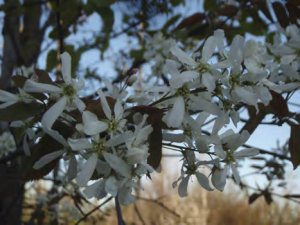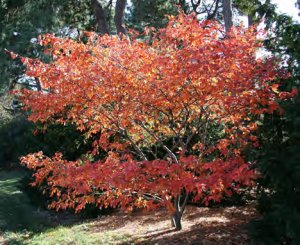AgEBB-MU CAFNR Extension
Green Horizons
Volume 24, Number 2
Spring 2020
Species Spotlight: Serviceberry (Amelanchier spp.)
Hannah Hemmelgarn, Center for Agroforestry
 |
| Above: Early spring flowers are an attractive landscape feature. Photo credit: Hannah Hemmelgarn |
Juneberry, serviceberry, shadbush, saskatoon; no matter what name you ascribe to this small tree or large shrub, Amelanchier (many species, most commonly arborea in Missouri) is well loved by both humans and wildlife. This deciduous, early-flowering woody perennial typically reaches 15-25 ft. tall, with blooms March through early May. As their names suggest, flowering time is often associated with ground thaw, when a burial service (thus, serviceberry), would be feasible, and fruits are ripe for picking in June (Juneberry). In the Rosaceae family, their five-petaled fragrant white flower clusters are a treat to encounter in early spring, whether in the understory of a healthy forest, or as a native addition to a farm, garden, or urban landscape.
 |
| Above: Clusters of berries are attractive to birds and other wildlife. Photo credit: Gardenia Garden Design |
Currently underutilized as a specialty crop, Amelanchier is a promising perennial crop in agroforestry systems for a number of reasons. Unlike elderberry and many other berry shrubs commonly grown for human consumption (e.g. blackberries, raspberries etc.), serviceberries are not likely hosts for the spotted winged drosophila fly, since their mature fruits precede SWD arrival. Hardy in zones 4-9, the shrub-like tree is well suited to climate variability in the Midwest. Juneberries, which grow in palm-sized clusters, are sweet and delicious fresh or processed, similar in size to a blueberry, with more complex cherry-like flavors. Since the seeds within the berry are very small, the fruit can be consumed in juicy handfuls without additional processing needed. However, a pie or preserve made from the berries is a wonderful way to add value and appeal. As a landscape planting, Serviceberry's finely
toothed obovate leaves also offer beautiful fall color as a seasonal complement to early spring flowers.
 |
| Above: Fall color adds additional appeal. Photo credit: Nebraska Forest Service |
The greatest challenge for maximum berry harvest is competition with birds, who also enjoy their sweet fruits. Noisemakers and scarecrow figures can reduce this pressure, as can inter-planting and a timely harvest. Entomosporium leaf spot (fungal) has also been known to affect Amelanchier in particularly wet years, although has not been shown to substantially impact yields. As the plant becomes more popular, the bottleneck for cultivation may simply be quantity of cultivar planting stock. Look for cultivars that have been selected for large, sweet fruit and disease resistance, including Pembina, Smokey, Parkhill, Autumn Brilliance, Robin Hill, Ballerina, Prince Charles, Honeywood, Regent, and Princess Diana.
Further resources on Amelanchier for wildlife, landscaping, and cultivation:
- Dirr, M. (1998). Manual of Woody Landscape Plants, 5th edition. Stipes Publishing L.L.C., Champaign, IL. 1250 pp.
- Hodde, M. (2017). Juneberries. Cornell Cooperative Extension, Seneca County. http://senecacountycce.org/agriculture/juneberries
- Kaiser, C. & M. Ernst (2017). Juneberries. CCD-CP-11. Lexington, KY: Center for Crop Diversification, University of Kentucky College of Agriculture, Food and Environment. http://www.uky.edu/ccd/sites/www.uky.edu.ccd/files/juneberry.pdf
- Reich, L. (2004). Uncommon Fruits for Every Garden. Timber Press, Portland, OR. 308 pp.
